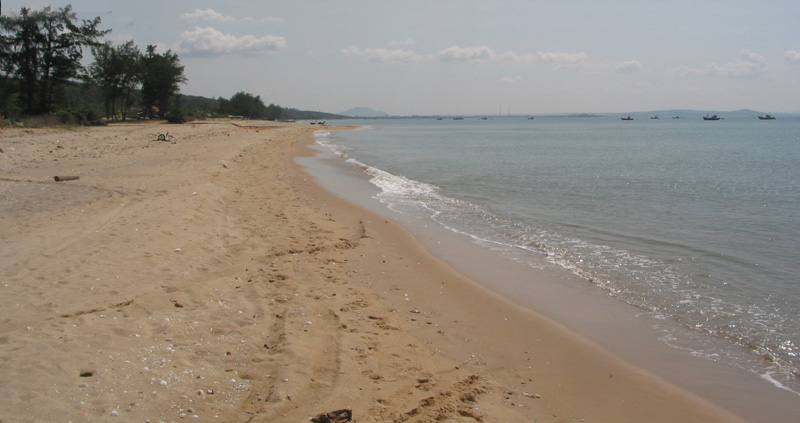DECLASSIFIED
Web site by Craig Slaughter © 2009
This is not an official USMC site.
OperationStarlite.com
HISTORY
Republic of South Vietnam - August 1965
On August 15 the Marines received their first break. A deserter from the Vietcong 1st Regiment in-formed General Thi of a major build-up of enemy Maine Force units in the Van Tuong village complex, twelve miles southeast of Chu Lai along the coast. The VC goal was to achieve a great psychological victory by surprising the isolated marine base at Chu Lai in the first major engagement between American and enemy forces.
General Thi, informing none of his own subordinates, immediately relayed the information to General Walt. Marine intelligence had by this time received sufficient evidence on its own to corroborate the deserter's story. Colonel Edwin Simmons, newly arrived operations officer for III MAF, recommended a "spoiling attack" to prevent the anticipated VC strike against Chu Lal. The timing was fortuitous. The arrival of reinforcements at the Chu Lai base on August 14 enabled Walt to reassign two experienced combat battalions, 2d Battalion of the 4th Marines (or 2/4), and 3d Battalion, 3d Marines (3/3) to the command of Colonel Oscar F. Peatross, commander of the 7th Marines. In addition, another marine battalion, afloat offshore, served as a reserve force that could be thrown into the battle when and where necessary. Finally, two U.S. Navy ships in the area, the U.S.S. Galveston and U.S.S. Cabildo, could provide offshore fire support. The operation, code-named Starlite, would be a classic marine encounter, combining land and sea forces, including an amphibious landing and coordination with the navy. It would be a very different battle for the Vietcong, accustomed to fighting with their backs to the sea, knowing that against South Vietnamese forces the water could always be used as an avenue of escape.
Conducting an aerial reconnaissance of the operational area, which was about ten miles south of Chu Lai, Colonel Peatross found that the terrain was dominated by sandy flats, broken by numerous streams and an occasional wooded knoll. The scattered hamlets possessed paddy areas and dry crop fields. While airborne, Peatross selected the assault beach as well as three landing zones among the sand flats, about one mile inland from the coast.
Operation Starlite began inauspiciously at 10:00 A.M. on August 17, when Company M of the 3d Battalion, 3d Marines, took a short ride south of Chu Lai before marching four miles farther south and camping for the night just north of Van Tuong. They met only light resistance and, since marine patrols in the area had been frequent, aroused no suspicion. Seven hours after Company M departed, the rest of the 3/3 and the command group embarked on three amphibious ships which, after a decoy maneuver, arrived in the area of the landing beach at five in the morning of August 18. Fifteen minutes before the 6:30 A.M. H-hour, marine artillery and jets began to pound the three landing zones west of Van Tuong, LZ Red, LZ White, and LZ Blue. Eighteen tons of bombs and napalm were dropped, adding to the firing of 155MM guns. At H-hour the troops of the 3/3 began their beach assault and pushed inland as planned. At 6:45 A.M. Company G of the 2/4 landed at LZ Red, while Company E landed at LZ White and Company H landed at LZ Blue forty-live minutes later. The 3/3 approached Van Tuong from the south, while companies E, G, and H of 2/4 were to move in from the west. Company M blocked any retreat to the north by the VC, and the navy ships prevented an escape to the east via the South China Sea. Van Tuong and the Vietcong were surrounded. For the most part, the Marines met little resistance as they closed in, but fierce fighting broke out near LZ Blue.
In the Vietnam War, intelligence was never precise and Company H had landed right in the middle of the Vietcong 60th Battalion and found itself surrounded. The VC let the first helicopters land without incident, then opened up on succeeding waves, a tactic they had used successfully against ARVN. Three U.S. Army UH-lB helicopter gun ships were called in to strafe the VC strong hold, a small knoll just east of LZ Blue called Hill 43. (Hills were given numerical distinctions according to the height in meters.) Meanwhile the infantry protected the LZ until the full company had landed. Company H commander, First Lieutenant Homer K. Jenkins, ordered an assault on the hill by one platoon, but it quickly stalled. Regrouping his men, and realizing that he had happened upon a heavy concentration of VC, Jenkins ordered in strikes against Hill 43 and then assaulted it with all three of his platoons. Reinforced by close air support and the Marines overran the enemy position, claiming six KIA at one machine-gun position alone. Hill 43 was taken.
Heavy fighting also took place in the village of An Cuong (2)-approximately two miles northeast of Hill 43 when two platoons of Company I attempted to clear the village of enemy snipers. After an initial setback, the company's reserve platoon was thrown into battle and the troops cleared the village. Company I's commander, Captain Bruce D. Webb, was among those killed in the early fire, and his company executive officer, First Lieutenant Richard M. Purnell, assumed command of the successful counter assault. Purnell counted over fifty enemy bodies when the fighting ended. One Company I squad leader, Corporal Robert E. O'Malley, single-handedly killed eight Vietcong that day and became the first marine to win the Medal of Honor in Vietnam. (Later, a posthumous award was made to Captain Frank S. Reasoner, killed in action in July.)
The most dramatic fighting of the day was the result of another favorite VC tactic :ambushing a relief column. between 11:00 AM. and noon Major Andrew G. Comer sent a resupply column to aid beleaguered Company I. The column, which included three flame tanks, the only tactical fire support available, quickly lost its way. Suddenly, VC recoilless rifle fire and a barrage of mortar rounds rendered the tanks useless in providing fire support. Using only their small arms, the entrapped Marines attempted to hold the advancing VC infantry. The marine radio operator panicked and, according to Major Comer, "kept the microphone button depressed the entire time and pleaded for help. We were unable to quiet him sufficiently to gain essential information as to their location." Finally Comer organized a rescue mission, led by the already exhausted Company I and including the only available M48 tank. By luck, one of the trapped flame tanks managed to break through the VC infantry and return to Comer's command post. The crew chief was able to lead the rescue mission to the location of the column. Approaching the besieged supply column, the relief force quickly drew heavy fire. Recoilless rifle fire knocked out the M48. Within minutes five Marines lay dead and seventeen wounded. Comer called for artillery fire and air support, and enemy fire soon sub-sided. As Comer put it, "It was obvious that the VC were deeply dug in, and emerged above ground when we presented them with an opportunity and withdrew whenever we retaliated or threatened them.
The heavy fighting of the first day proved to be the only major contact of the seven-day operation. For Companies H and l it had been an exhausting time. Together the two companies had sustained casualties amounting to over 100 of their original 350 men, including 29 dead, but in return they claimed 281 VC dead.
Aftermath of victory
On August 19, Starlite's second day, sporadic and isolated fire came from enemy soldiers covering their main force's retreat, but organized resistance had ended. The operation extended for five more days with the Marines, now joined by ARVN troops, conducting village-by-village searches. At its conclusion the Marines could claim 573 confirmed enemy dead and 115 estimated, while suffering 46 deaths themselves and 204 wounded. The battle had been won by overwhelming American firepower. Artillery support from Chu L,ai had fired over three thousand rounds while the navy ships had supported the infantry with 1,562 rounds, sunk seven sampans apparently carrying fleeing VC, and pinned down one hundred enemy soldiers attempting to escape from the beach. Moreover, the Marines had benefited from the close coordination of tactical air power, a coordination that ARVN never seemed to achieve. General Walt later commented that air support was used "within 200 feet of our pinned down troops and was a very important factor in our winning the battle. I have never seen a finer example of close air support." The Marines had won by doing what American troops do best coordinating their firepower on land, sea, and air. But most important, the Marines had learned at least one valuable lesson from Starlite.
At General Thi's insistence no ARVN commander was even aware of the planned operation. At the last moment General Hoang Xuan Lam, whose men augmented the Marines during the second day of operations, was in formed of his role. Even American reporters did not arrive on the scene until the second day. As a result the VC were caught by total surprise. Future operations, similar in nature to Starlite, were much less successful. For political reasons the Marines had to inform ARVN of future operational plans and there by risk the likelihood of this knowledge somehow reaching the enemy.
The experience taught many minor lessons as well. The planned ration of two gallons of water per man each was insufficient in the heat of Vietnam. The M14 automatic rifle proved too heavy and bulky, especially for support troops who often crammed into small personnel carriers and the search began for a lighter, more maneuverable basic weapon.
Finally, for the Marines the operation dramatized the complexity of fighting a war among civilians. Publicly the Marines declared that only fortified enemy villages were destroyed, but the official "after-action" report stated: "Instances were noted where villages were severely damaged or destroyed by napalm or naval gunfire, where the military necessity of doing so was dubious.
Perhaps the most important outcome of Operation Starlite was its psychological lift. In the first major engagement between American troops and Main Force Vietcong soldiers the Americans had been victorious. Had the American forces lost, a real possibility given their in experience, the effects might have been severe indeed. The old tactics of the VC, which had worked so well against ARVN, failed to rout the Marines. So the enemy learned a lesson as well; it would be many months before they would again stand to fight against the Marines
For the Marines, Starlite, or the Battle of Chu Lai as became known in their lore, took on an almost mythic' importance. For those Marines who came later and for, whom the landings at Iwo Jima and Inchon Beach were the glory of another generation, the Battle of Chu Lai remained for many months the only evidence of what the Marines could do if the enemy stood and engaged.
Used by permission courtesy of Vets With A Mission


